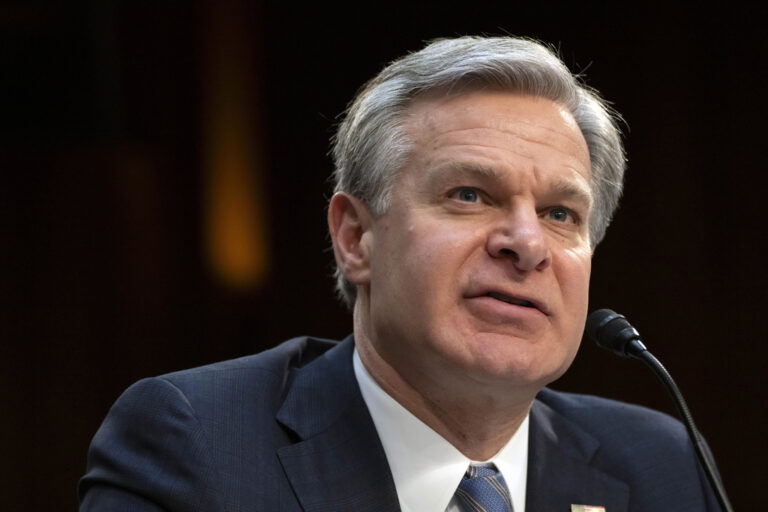With heat waves spreading across the United States, President Joe Biden on Thursday plans to unveil new steps to protect workers, improve weather forecasts and make drinking water more accessible, the White House says.
The announcement comes as nearly 40% of the U.S. population faces heat advisories, according to the National Weather Service. High temperatures have already scorched the Southwest this month, and more heat is expected in the Midwest and the Northeast in the coming days. Washington won’t be spared, and the heat index could reach 110 on Friday.
It’s a worldwide problem, and scientists calculate that July will be the hottest month on record.
Biden’s plans represent an effort to address the immediate effects of climate change as he faces pressure from fellow Democrats and labor groups to do more to safeguard vulnerable populations. The steps supplement his long-term agenda for reducing greenhouse gas emissions and deploying clean energy technology, policies that may not pay dividends for years to come while global temperatures continue to rise.
White House press secretary Karine Jean-Pierre described the heat waves as “a difficult time” and said Biden was treating climate change with “the urgency it requires.”
Biden is directing the Department of Labor to increase inspections of potentially dangerous workplaces such as farms and construction sites. He also wants heightened enforcement of heat safety violations.
As part of the initiative, the department will issue a hazard alert notifying employers and employees about ways to stay protected from extreme heat, which has killed 436 workers since 2011, according to federal statistics.
The Biden administration plans to spend $7 million to develop more detailed weather predictions to anticipate extreme weather like heat waves, plus $152 million to boost drinking water infrastructure and climate resilience in California, Colorado and Washington.
Biden will be joined on Thursday by the leaders of the Federal Emergency Management Agency and the National Oceanic and Atmospheric Administration. The mayors of Phoenix and San Antonio, two cities that have suffered from the heat waves, are expected to participate in the White House event virtually.
Phoenix has seen at least 27 days in a row of temperatures exceeding 110 degrees Fahrenheit (43.3 degrees Celsius). No other major city — defined as the 25 most populous in the United States — has had any stretch of 110-degree (43.3-degree) days or 90-degree (32.2-degree) nights longer than Phoenix, said weather historian Christopher Burt, of the Weather Company.
Maricopa County, where Phoenix is located, reported recently that there were 18 heat-associated deaths between April 11 and July 15. Another 69 deaths remain under investigation. There were 425 heat-associated deaths in the county last year.
San Antonio saw at least 15 straight days of 100-plus F (38-plus C). At least 13 deaths in Texas have been blamed on the extreme heat.
Thursday’s announcement follows other steps that the Biden administration has taken to adapt to increasing threats from extreme heat. Among those it is highlighting:
The Department of Labor is developing a standard for how workplaces deal with heat. The proposed rule by the Occupational Safety and Health Administration would require employers to provide adequate water and rest breaks to outdoor workers, as well as medical services and training to address signs and symptoms of heat-related illness. OSHA is holding meetings this summer to hear comments on how the heat standard would affect small businesses.
To keep low-income populations cool, the Department of Health and Human Services expanded its Low Income Home Energy Assistance Program to provide more access to air conditioning and cooling centers such as libraries, senior centers or other public buildings. The Environmental Protection Agency also has provided assistance to help communities develop cooling centers within schools.
The National Oceanic and Atmospheric Administration has been helping cities and towns map “heat islands” with dense buildings and fewer trees, and the Department of Agriculture issued guidance for creating more tree canopy coverage, which helps with cooling environments.
In addition, the administration launched a website called heat.gov with interactive maps, weather forecasts and tips for keeping cool amid record-breaking heat.
More than 100 members of Congress, led by Democratic Reps. Greg Casar and Sylvia Garcia of Texas and Judy Chu of California have called on the administration to implement the new heat standard for outdoor workers as quickly as possible.
“We know extreme weather events such as heat waves are becoming more frequent and more dangerous due to climate change. Urgent action is needed to prevent more deaths,″ the lawmakers wrote in a letter Monday.
The United Farm Workers and other groups also called on OSHA to immediately issue a nationwide rule protecting outdoor workers after farm worker deaths this month in Florida and Arizona.
“Farm workers need and deserve the access to shade, water and paid breaks,” said UFW President Teresa Romero. “How many more workers will we let dangerous heat and callous employers kill before this nation acts?”
Douglas Parker, assistant Labor secretary for occupational safety and health, called heat illness prevention a top priority. As OSHA works toward a final rule, the agency is enhancing enforcement efforts “to make sure employers and workers understand the dangers of heat illness and how to prevent it,” Parker said in a statement.
Casar, a freshman lawmaker from Austin, staged a “thirst strike” on Tuesday outside the U.S. Capitol, forgoing water breaks for nearly nine hours, to protest a new Texas law that bans local governments from requiring water breaks and other safety measures for outdoor workers. Casar called the law “insane″ and accused Republican Gov. Greg Abbott of being “on the wrong side of history.” Republican lawmakers and other supporters of the law say it eliminates a patchwork of local regulations that are burdensome to businesses, and they say it won’t stop workers from taking breaks.
At least 42 workers died in Texas between 2011 and 2021 from environmental heat exposure, according to the U.S. Bureau of Labor Statistics.
“Democrats are going to stand up for common sense and for working people,″ Casar said.
Ladd Keith, an assistant professor at the University of Arizona who studies heat policy and governance, said the record-breaking heat much of the nation is experiencing “is very much in line with climate change projections.” While not surprising, “they’re certainly a continuation of a concerning trend of climate impacts that we’ve seen,” he said.
Despite the recent headlines, rising temperatures have typically not received the same level of attention as other climate risks, such as flooding and wildfires, Keith said.
“Heat has just not been a topic at the national level or local level that we’ve even considered addressing until the last couple of years,” he said.
However, Keith said the administration has ramped up its focus because of searing weather events, such as the heat dome in the Pacific Northwest in 2021 that prompted record temperatures and dozens of deaths across the region.
OSHA fined a Florida farm supervisor last month for exposing workers to excessive heat after a worker from Mexico died at a farm in Parkland, Florida. Investigators determined the worker’s death could have been prevented if a labor contractor had followed established safety practices regarding heat-related hazards.
(AP)












One Response
They have eyes and do not see, ears and do not hear!
Climate change – perhaps it’s Hashem’s wrath at the disintegration of humanity to a level perhaps worse than in the time of Noach. Hashem, promised never to bring a mabul again. I heard a very choshuv Rosh Yeshivah say that if not for that promise He would have brought it already.
OOroo yeshanim mishnaschem……